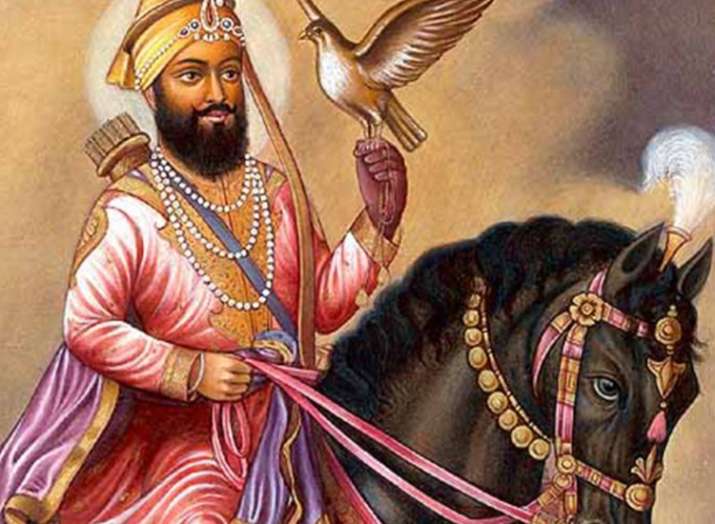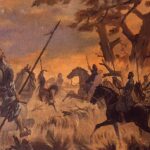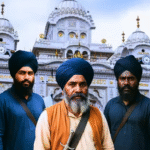Guru Gobind Singh ([gʊɾuː goːbɪn̯d̯ᵊ sɪ́ŋgᵊ]; from 22 December 1666 – to 7 October 1708), born Gobind Rai, was the tenth Sikh Guru, a spiritual hero, hero, poet, and philosopher. When his father, Guru Tegh Bahadur, was assassinated by Aurangzeb, Guru Gobind Singh was officially appointed Sikh leader at the age of nine, becoming the tenth and last Sikh Guru. His four sons died during his lifetime – two in battle, two were killed by the Mughal army.
Among his significant contributions to Sikhism was the establishment of the Khalsa Sikh war power community in 1699 and introduced the five Ks, the five titles of faith worn by the Khalsa Sikhs at all times. Guru Gobind Singh called Dasam Granth his songs are a sacred part of Sikh prayers and rituals of Khalsa. He is also credited with completing and incorporating the Guru Granth Sahib as the main text of Sikhism and the Eternal Heritage.
The period following the assassination of Guru Tegh Bahadur – father of Guru Gobind Singh, was a period when the Mughal Empire under Aurangzeb was a hostile enemy to the Sikh people. Sikhs opposed, led by Gobind Singh, and Muslim and Sikh conflicts escalated during this period. [60] Both the Mughal authorities and the Aurangzeb army were of great interest to Guru Gobind Singh. Aurangzeb ordered the extermination of Guru Gobind Singh and his family.
Guru Gobind Singh believed in Dharam Yudh (the war for the protection of justice), a war fought as a last resort, not for revenge or greed or any other harmful cause. According to Guru Gobind Singh, one should be prepared to die in order to stop oppression, end persecution, and defend one’s religious values. He led fourteen battles for that purpose, but he did not conquer, nor did he damage anyone’s place of worship.
Muslim historians of the Mughal court wrote about Gugu Gobind Singh and the politics of his day, and these official Persian accounts were readily available and the basis for the colonial era was the English language interpretation of Sikh history.
According to Dhavan, Persian inscriptions dictated by Mughal court historians during the lifetime of Guru Gobind Singh were hostile to him, but merely presented Mughal’s views. They believed that the traditional Sikh culture was corrupted by him, by creating an army determined to oppose the Imperial army. Dhavan writes that some Persian writers who wrote decades or a hundred years after the death of Guru Gobind Singh emanated from a complete reliance on Mughal court records denigrating Guru, including stories from the Sikh gurbilas text praising Guru.
Mughal accounts suggest that the Muslim hierarchy viewed the Sikh Panth as a sect, and after the battle of Anandpur, the Mughals felt that Guru’s forces were one of the most powerful forces in the Mughal Empire.
The postwar years
After the Second World War in Anandpur in 1704, the Guru and its remaining troops moved and settled in various places, including hiding places such as the Machhiwara forest south of Panjab.
Some of the various places in northern, western, and central India that Guru settled after 1705, include Hehar and Kirpal Das (maternal uncle), Manuka, Mehdiana, Chakkar, Takhtupura and Madhe and Dina (Malwa region (Punjab)). He lived with relatives or faithful Sikhs as the three grandchildren of Rai Jodh, devoted to Guru Har Gobind.
Zafarnama
Guru Gobind Singh saw the war behavior of Aurangzeb and his army against his family and his people as betrayal, injustice, injustice, and disrespect. After all of Gugu Gobind Singh’s children were killed by the Mughal army and the battle of Muktsar, Guru wrote a defamatory letter in Persian to Aurangzeb, called Zafarnama (literally, “victory book”), a book the Sikh tradition thinks of. important in the late 19th century.
Guru’s letter was strong but included Aurangzeb. He sued the Mughal emperor and his superiors spiritually, accusing them of misconduct in the governance and conduct of the war. The letter predicted that the Mughal Empire would soon come to an end, for it was full of persecution, lies, and immorality. The book is spiritually based on Guru Gobind Singh’s beliefs about justice and dignity without fear.
There are two stories of why Guru went to Nanded, one that he helped Bahadur Shah to oppress the leaders of the Marathas and the Boi Dynasty or that he went there just to preach Sikhism as he had just marveled at the rebellion of Kam Bakhsh and the soldiers present. tired and decided to camp. The second is the most popular narrative.








